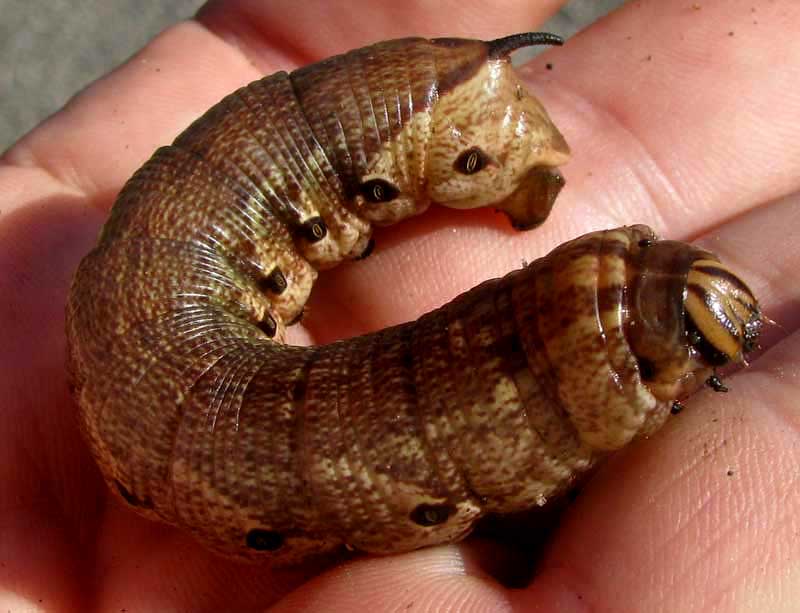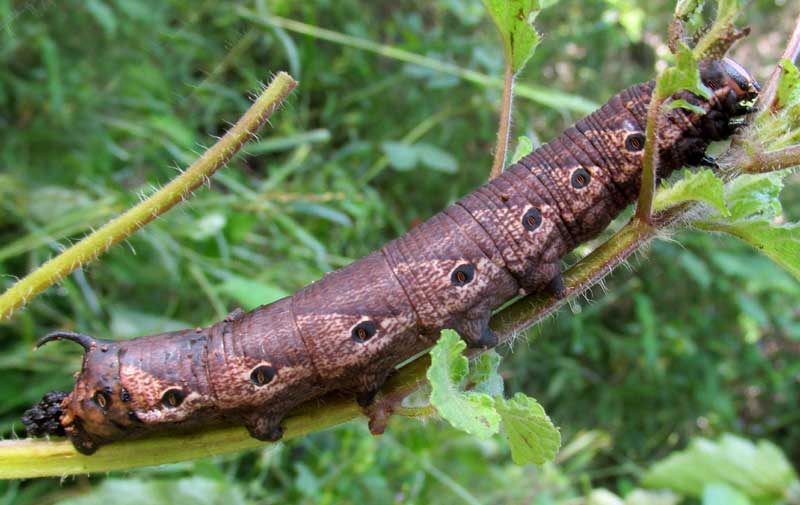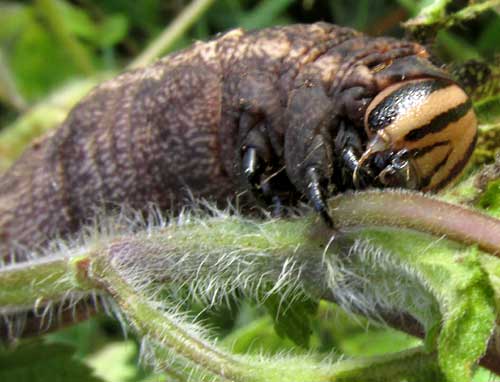Excerpts from Jim Conrad's
Naturalist Newsletter

from the December 4, 2011 Newsletter issued from Hacienda Chichen Resort beside Chichén Itzá Ruins; limestone bedrock; elevation ~39m (~128ft), N20.675°, W88.569°; central Yucatán state, MÉXICO
SWEETPOTATO HORNWORM
This week in the center of the little asphalt road running south of Pisté to Yaxuná a long, thick, succulentand brown caterpillar turned up, the one shown above.
It's AGRIUS CINGULATA, whose adult stage is known as the Pink-spotted Hawkmoth, and whose caterpillar stage is called the Sweetpotato Hornworm. It's in the same family as last week's Cassava Hornworm, the Sphinx Moth Family, the Sphingidae, but in an entirely different genus.
We don't have Sweet Potatoes here but the abundantly weedy, late-season cornfields on both sides of the road our hornworm was crossing were nothing less than theaters of morning-glory twinings, and Sweet Potato vines are just morning-glories issuing from oversized tubers. Once again we have a hornworm turning up exactly where it ought to be.
I read that Sweetpotato Hornworms feed both day and night, and pupate in a chamber in the soil. One to three generations per year may be produced. They're found from the southern US south through Mexico and Central America to northern South America. Sometimes in late summer the adult moths wander as far north as British Columbia and southeastern Canada, and have even turned up on the western coast of Europe. A similar south-ranging flight taking them far from their main distribution area takes place in South America.
from the August 28, 2016 Newsletter issued from Hacienda Chichen Resort beside Chichén Itzá Ruins, central Yucatán MÉXICO
SWEET POTATO HORNWORM ON LANTANA
This week a big, brown hornworm turned up chewing on a strong-smelling sprig of Wild Sage, Lantana camara, growing along a forest trail. Below, you can see the formidable looking, three-inch-long (8cm) critter at:

A close-up of the attractively striped head is shown below:

When the above pictures were sent to volunteer identifier Bea in Ontario she let me know that we'd already seen this one, the Sweetpotato Hornworm. However, our earlier encounter was in the middle of an asphalt road, so this week's find still is good because now we know more about its ecology. Mainly, that it feeds on more than Sweet Potatoes, and members of the plant family Sweet Potatoes belong to, the Morning-glory Family. Bea found that, with regard to the caterpillars' food, "The majority of records ... are from Bignoniaceae, Oleaceae, Verbenaceae and Solanaceae." Our caterpillar's Lantana camara belonged to the Verbena Family, the Verbenaceae, and now we'll know to also look for them on viny members of the Trumpet-creeper Family, the Bignoniaceae, the Olive Family (Oleaceae) and the Tomato or Black Nightshade Family, the Solanaceae.